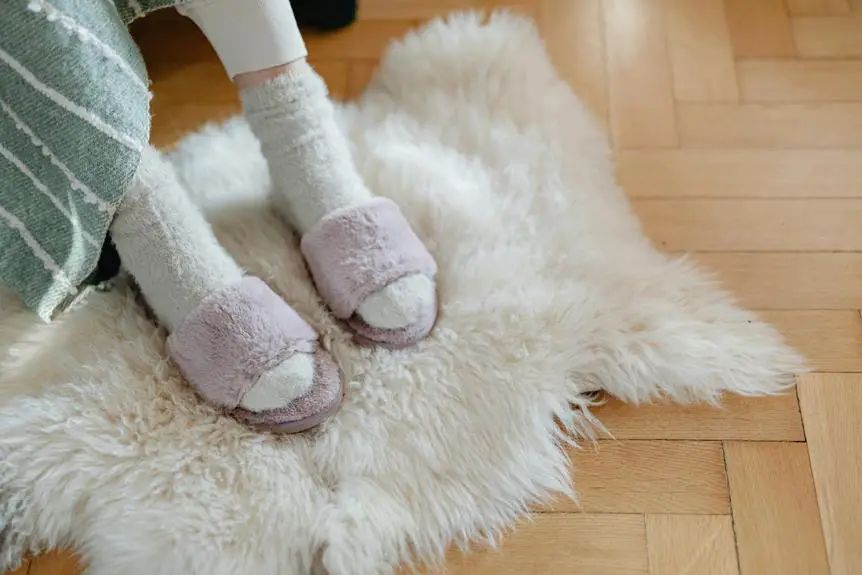You're likely familiar with both French terry and fleece as popular fabrics used in outdoor gear and clothing. But have you ever wondered how they compare in terms of warmth? While fleece is known for its exceptional warmth, French terry has its own unique advantages. As you explore the differences between these two fabrics, you'll discover how their distinct properties make them suitable for different climates and activities. Let's take a closer look at the warmth, breathability, and moisture-wicking properties of French terry and fleece to determine which one comes out on top.
Table of Contents
French Terry Vs Fleece Warmth
When it comes to warmth, French terry and fleece have distinct differences in terms of their ability to retain body heat and provide insulation.
Fleece is generally warmer than French terry due to its thicker and denser fabric. Fleece traps warm air close to the skin, making it an excellent choice for colder climates.
French terry is a more breathable fabric, but it still provides decent warmth.
French terry has its own advantages. It's often less bulky than fleece, making it a great choice for layering. You can wear it under a jacket or sweater without feeling too bulky.
Additionally, French terry is often less prone to pilling than fleece, which means it will look newer for longer.
While fleece may be warmer, French terry's breathability and versatility make it a great choice for milder climates. Ultimately, the choice between French terry and fleece comes down to your personal preferences and needs.
Breathability Comparison
French terry generally offers better breathability than fleece, allowing for a full range of motion and moisture-wicking properties that keep you cool and dry. This is especially important during high-intensity activities or in warmer climates, where you'll appreciate the extra airflow and comfort.
French terry's unique weave creates a fabric that's both soft and breathable, making it ideal for activewear and outdoor gear.
In contrast, fleece can sometimes feel stiff and restrictive, limiting your movement and trapping heat. While it's still a great insulator, it can't match French terry's breathability. You'll notice the difference when you're hiking or biking on a warm day – French terry will keep you cooler and drier, while fleece might leave you feeling hot and sweaty.
Moisture Wicking Properties
When it comes to moisture wicking properties, you'll want to consider how well French Terry and Fleece fabrics can draw sweat away from your skin.
You'll likely notice that one of these fabrics excels at breathability levels, allowing for a cooler and drier wear.
Breathability Levels
The breathability of French terry and fleece fabrics differ significantly, with French terry generally offering better moisture-wicking properties.
You'll notice that French terry allows for better airflow and moisture transfer, keeping you cooler and drier. This is especially important during high-intensity activities or in warm weather.
On the other hand, fleece can trap heat and moisture, making you feel warmer and more uncomfortable.
When it comes to breathability, French terry is the clear winner. You'll appreciate the soft, natural fibers that allow for excellent airflow and moisture transfer.
This means you can enjoy your outdoor activities without feeling weighed down by heavy, sweaty clothing. In contrast, fleece can feel stiff and synthetic, trapping heat and moisture.
While fleece has its advantages, breathability isn't one of them. If you prioritize moisture-wicking properties and airflow, French terry is the better choice.
Drying Speed
Drying speed is another key advantage of French terry fabrics, as they typically dry much faster than fleece due to their natural fibers and superior moisture-wicking properties.
You'll appreciate how quickly you can get back to your outdoor activities without having to wait for what feels like an eternity for your gear to dry.
French terry's moisture-wicking properties allow it to draw sweat away from your skin and dry it quickly, making it an ideal choice for activewear.
In contrast, fleece tends to hold onto moisture, making it take longer to dry.
This can be a major drawback for outdoor enthusiasts who need their gear to dry quickly.
You don't want to be stuck with a soggy jacket or pants that take forever to dry.
French terry's drying speed is just one of the many advantages it has over fleece.
Whether you're hiking, biking, or just lounging around, you'll appreciate the quick-drying properties of French terry.
Thermal Insulation Performance
Typically, French Terry and Fleece are compared in terms of thermal insulation performance. You're probably wondering which one keeps you warmer.
The answer lies in their ability to trap warm air. French Terry has a soft, plush pile that creates a layer of air next to the skin, reducing heat loss.
On the other hand, Fleece has a thick, dense pile that traps warm air, making it a better insulator. However, Fleece can be too warm in mild temperatures, causing you to sweat. French Terry, being a more breathable fabric, allows for airflow, making it suitable for a wider range of temperatures.
When it comes to thermal insulation performance, Fleece is generally better than French Terry. But, French Terry's breathability makes it a great choice for milder climates.
Ultimately, the choice between French Terry and Fleece depends on your specific needs and preferences.
Fabric Weight and Thickness
When comparing French Terry and Fleece, you'll notice that Fleece generally has a higher weight and thickness due to its dense pile construction. This makes Fleece more effective at trapping warm air, but it also makes it heavier and more prone to pilling over time.
French Terry, on the other hand, has a more open weave and a lighter weight, which makes it ideal for next-to-skin applications where moisture-wicking is important. You'll find that French Terry tends to drape better than Fleece, which can be stiff and awkward to work with.
In terms of thickness, French Terry tends to be more variable, depending on the type of cotton used and the tightness of the weave. However, a well-made French Terry can be just as warm and cozy as a similar weight of Fleece. It's all about the quality of the construction, not the type of fabric itself.
Outdoor Gear Applications
French Terry and Fleece are two fabrics commonly used in outdoor gear.
French Terry is a type of fabric that is known for its softness and warmth. It is often used in casual, everyday clothing. However, it is not typically used in outdoor gear due to its relatively low insulation value and breathability.
Fleece, on the other hand, is a popular choice for outdoor enthusiasts. It is known for its warmth, breathability, and moisture-wicking properties. Fleece is often used in jackets and other outdoor gear due to its high insulation value and ability to retain warmth while allowing moisture to escape.
When it comes to weight, fleece is generally lighter than French Terry. This is because fleece is often made from synthetic materials that are designed to be lightweight and compact. French Terry, on the other hand, is often made from cotton or other natural fibers that are heavier and bulkier.
In terms of pack weight, fleece is generally a better choice for outdoor enthusiasts. This is because fleece is lighter and more compact than French Terry, making it easier to pack and carry on long hikes.
Hiking Jacket Insulation
French Terry and Fleece Insulation
French terry and fleece are two popular insulation options for hiking jackets that offer distinct benefits in outdoor gear applications.
Breathability
French terry is generally more breathable than fleece, making it a great choice for high-intensity activities.
Moisture-wicking
Fleece is often treated with moisture-wicking technology, which helps to keep you dry and comfortable.
Warmth
Fleece is generally warmer than French terry, especially in cold and windy conditions.
Durability
French terry is often more durable than fleece, with a longer lifespan and less prone to pilling.
Weight
French terry is often heavier than fleece, which can be a consideration for long-distance hikers.
Choosing between French Terry and Fleece
Ultimately, the choice between French terry and fleece comes down to personal preferences and hiking style. If you prioritize warmth and moisture-wicking technology, fleece may be the better choice. However, if you prefer a more breathable and durable option, French terry is worth considering.
Camping Gear Weight
Considering the weight of your camping gear is crucial for a comfortable outdoor experience. You want to pack light without sacrificing warmth and comfort.
When it comes to camping gear, every ounce counts. French terry and fleece are both popular choices for outdoor enthusiasts, but they differ significantly in terms of weight.
French terry is generally heavier than fleece due to its thicker and more dense fabric. However, this also means it provides better insulation and warmth.
On the other hand, fleece is incredibly lightweight and easy to pack. It's a great choice for backpackers and hikers who need to move quickly and efficiently.
If you're planning a long hike or backpacking trip, fleece might be the better choice. But if you're car camping or don't mind carrying a bit more weight, French terry could be the way to go.
Ultimately, the choice between French terry and fleece comes down to your specific needs and preferences.
Care and Maintenance
When it comes to caring for French terry and fleece, it's essential to follow specific washing and drying instructions to maintain their softness and durability.
Wash your French terry and fleece in cold water to prevent shrinkage and color fading.
Avoid using fabric softener or bleach, as these can damage the materials and reduce their warmth.
Dry your gear on a low heat setting or air dry to prevent damage from high heat.
Store your gear in a cool, dry place to prevent moisture buildup and damage.
Consider hand washing your gear to prevent damage from machine washing.
Frequently Asked Questions
Is French Terry Warmer Than Fleece?
You'll find that French terry and fleece have similar warmth levels, but French terry is slightly warmer due to its dense, plush pile construction that traps warm air better.
Does French Terry Breathe Better Than Fleece?
You'll find that French terry generally breathes better than fleece, allowing for airflow and moisture transfer, making it a great choice for active wear and outdoor gear.
Is French Terry More Moisture-Wicking Than Fleece?
You'll find that French Terry is generally more moisture-wicking than fleece, as it's designed to draw sweat away from your skin, keeping you dry and comfortable during activities.
Is French Terry Heavier Than Fleece?
You'll find that French Terry is generally heavier than fleece due to its denser weave and thicker yarns used in its construction, making it a warmer and more durable option for outdoor activities.
Can French Terry Be Used for Outdoor Gear?
You can definitely use French terry for outdoor gear, it's a great choice for jackets, pants, and hats. It's breathable, moisture-wicking, and provides excellent warmth, making it perfect for camping or hiking.
- How Does Ring Spun Cotton Affect Garment Fit and Shape Retention? - August 13, 2024
- What Are the Challenges in Producing Ring Spun Cotton? - August 13, 2024
- Is Ring Spun Cotton Suitable for Plus-Size Clothing? - August 13, 2024







